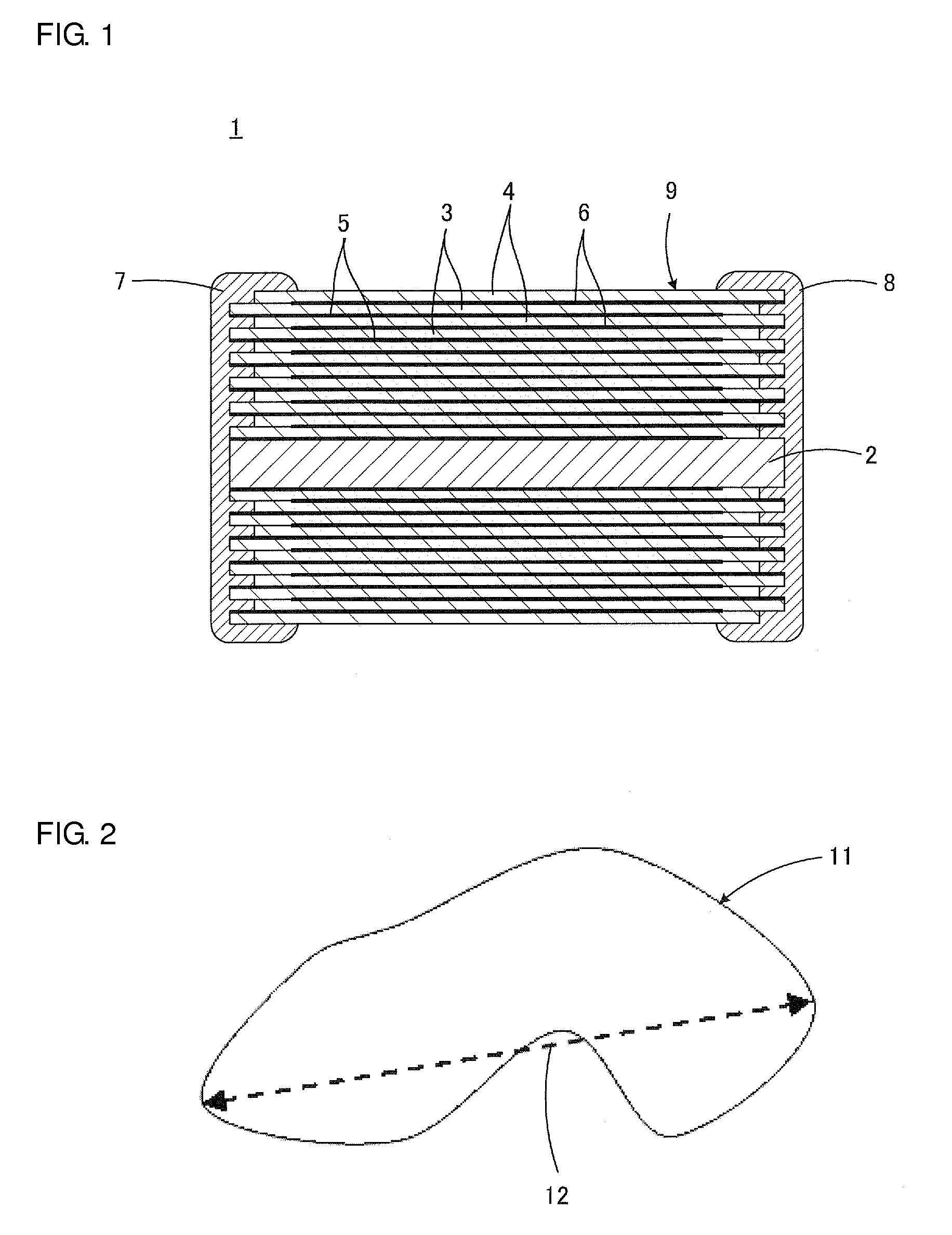Dielectric resin composition for film capacitor and film capacitor
a technology of dielectric resin and film capacitor, which is applied in the direction of fixed capacitors, stacked capacitors, fixed capacitor details, etc., can solve the problems of difficult to form a sheet having a stable thickness, difficult to form a sheet with a stable thickness, and inconvenient high temperature applications of dielectric resin films, etc., to achieve high heat resistance, increase the guaranteed temperature of a film capacitor, and high heat resistance
- Summary
- Abstract
- Description
- Claims
- Application Information
AI Technical Summary
Benefits of technology
Problems solved by technology
Method used
Image
Examples
experimental examples 1
[0060]An organic material 1 having the number of backbone carbon atoms and the amount of hydroxy groups described in Table 1 was mixed with ethyl acetate. The mixture was stirred to prepare a resin solution having an organic material 1 concentration of 7% by weight.
[0061]A shearing force was applied to the resin solution by passing the resin solution once through an orifice having a diameter of 0.125 mm and a length of 5 mm of a high-pressure homogenizer at 150 MPa. The resin solution which has been subjected to high-pressure homogenization was passed five times through a filter having a pore size of 0.45 μm to remove foreign matter.
[0062]An organic material 2 having the amount of NCO groups (isocyanate groups) described in Table 1 was added to the resin solution containing the organic material 1 after removal of foreign matter as described above in such a manner that the solid content was set to a value described in “Proportion of organic material 1 in cured article” in Table 1. St...
experimental examples 2
[0076]The same mixed solution as that of sample 1 in Experimental Example 1 was prepared.
[0077]Silica particles having an average particle size of 0.2 μm (dielectric constant: 4) and a silane coupling agent were added to a solvent containing toluene and ethanol in a ratio of 1:1 by weight. The mixture was stirred in a ball mill for 8 hours to prepare a silica particle dispersion in which the silica particles subjected to surface treatment with the silane coupling agent were dispersed.
[0078]The mixed solution and the silica particle dispersion were mixed such that the volume concentration of silica was 30% by volume. The resulting mixture was charged into a high-pressure homogenizer. A shearing force was applied to the mixture by passing the mixture once through an orifice having a diameter of 0.125 mm and a length of 5 mm at 150 MPa.
[0079]The resulting mixture was subjected to the same operations as in Experimental Example 1 to provide a film as a cured article. The glass transition...
experimental example 3
[0081]Experimental Example 3 examined preferred conditions of high-pressure homogenization for an organic material in which the number of backbone carbon atoms is 100 or more.
[0082]Specifically, the high-pressure homogenization sample 1 in Experimental Example 1 was performed under the conditions in which the polyvinyl acetoacetal solution serving as the organic material 1 was passed once through the orifice having a diameter of 0.125 mm and a length of 5 mm at 150 MPa. Then, the pressure and the number of passages were changed as described in Table 2. Variations of breakdown voltage and average breakdown voltages of the resulting films were compared.
[0083]
TABLE 2Number ofVariation ofAveragePressurepassagesbreakdown voltagebreakdown voltage 25 MPa20LargeLow 50 MPa20SmallLarge150 MPa1SmallLarge
[0084]As is clear from Table 2, where the pressure is 150 MPa, it was sufficiently high that a sufficient dispersion state could be provided even if the number of passages is set to 1, resultin...
PUM
| Property | Measurement | Unit |
|---|---|---|
| electric field strength | aaaaa | aaaaa |
| glass transition temperature | aaaaa | aaaaa |
| length | aaaaa | aaaaa |
Abstract
Description
Claims
Application Information
 Login to View More
Login to View More - R&D
- Intellectual Property
- Life Sciences
- Materials
- Tech Scout
- Unparalleled Data Quality
- Higher Quality Content
- 60% Fewer Hallucinations
Browse by: Latest US Patents, China's latest patents, Technical Efficacy Thesaurus, Application Domain, Technology Topic, Popular Technical Reports.
© 2025 PatSnap. All rights reserved.Legal|Privacy policy|Modern Slavery Act Transparency Statement|Sitemap|About US| Contact US: help@patsnap.com

